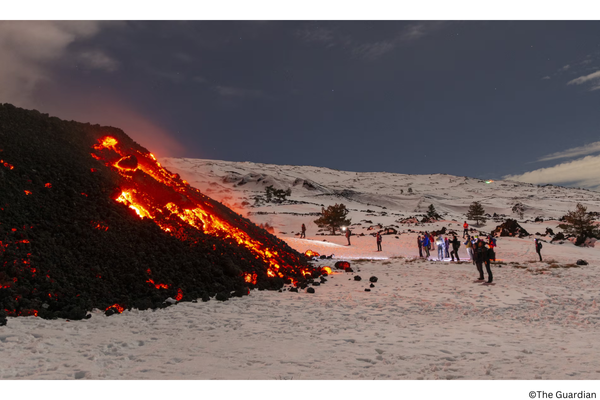Mount Etna, Europe’s most active volcano, erupted on 11 February 2025 and a huge ash cloud formed as lava spewed from the south-east crater. Since 17 February, the eruption has been affecting air traffic in Italy due to the spreading ash cloud, while lava flows continue to expand. Fortunately, they are travelling in a direction that poses no immediate danger to the island’s residents (De Ruiter, 2025), while the government is preparing for possible emergency scenarios and has already put together units of volunteers who can provide immediate assistance if necessary (De Ruiter, 2025).
The eruption, combined with the current snowfall, is attracting thousands of onlookers to Sicily who want to experience the natural spectacle up close. However, this not only jeopardises themselves, but also the island’s inhabitants. Due to the large number of visitors, the often narrow roads are blocked by parked cars, which means that rescue services can no longer reach people in need unhindered (Tondo, 2025).
The head of the regional civil defence in Sicily describes the influx of tourists as ‘extremely dangerous’ and warns of the risks, which are exacerbated by limited visibility, especially at night. This is increasingly leading to falls or even people sinking into the snow. Despite urgent warnings and instructions not to get closer than 500 metres to the lava flows, many tourists disregard these safety measures (Tondo, 2025) and the lack of caution is currently leading to numerous rescue operations due to injuries or reports of missing persons. Some visitors even take advantage of the exceptional conditions to ski between the lava flows – a dangerous endeavour. The contact between the lava and snow can vaporise it suddenly, releasing enormous amounts of heat energy. This can lead to explosive eruptions that hurl rocks and debris into the air (Tondo, 2025). This, in combination with the behaviour of tourists, makes the eruption particularly dangerous. Mount Etna erupts every few weeks, most recently in the summer of 2024 (Prack & Dümmer, 2024), with major eruptions occurring at irregular intervals every few years. Eruptions that can destroy entire villages occur on average every 250 years (Bäumer (BR), 2015).
Status 21.02.2025

Literature:
Bäumer (BR), F. (2015, November 3). Der Rhythmus des Ätna | W wie Wissen. Erstes Deutsches Fernsehen (ARD). Retrieved February 21, 2025, from https://www.daserste.de/information/wissen-kultur/w-wie-wissen/sendung/2012/der-rhythmus-des-aetna-100.html
De Ruiter, E. (2025, February 18). Sizilien: Tausende bestaunen den spektakulären Ausbruch von Ätna. Euronews. https://de.euronews.com/my-europe/2025/02/18/sizilien-tausende-bestaunen-den-spektakularen-ausbruch-von-atna
Prack, N., & Dümmer, K. (2024, August 5). Ausbruch des Ätna auf Sizilien: So ist die Lage am Flughafen Catania. ADAC.de. https://www.adac.de/news/vulkan-aetna-flughafen/
Tondo, L. (2025, February 18). Thousands of tourists flock to see Etna eruption, blocking rescue services: Tourists blocking streets and indulging in ‘dangerous’ behaviour, say Sicilian officials. The Guardian. https://www.theguardian.com/world/2025/feb/18/thousands-of-tourists-flock-to-see-etna-eruption-blocking-rescue-services

Image source: The Guardian


